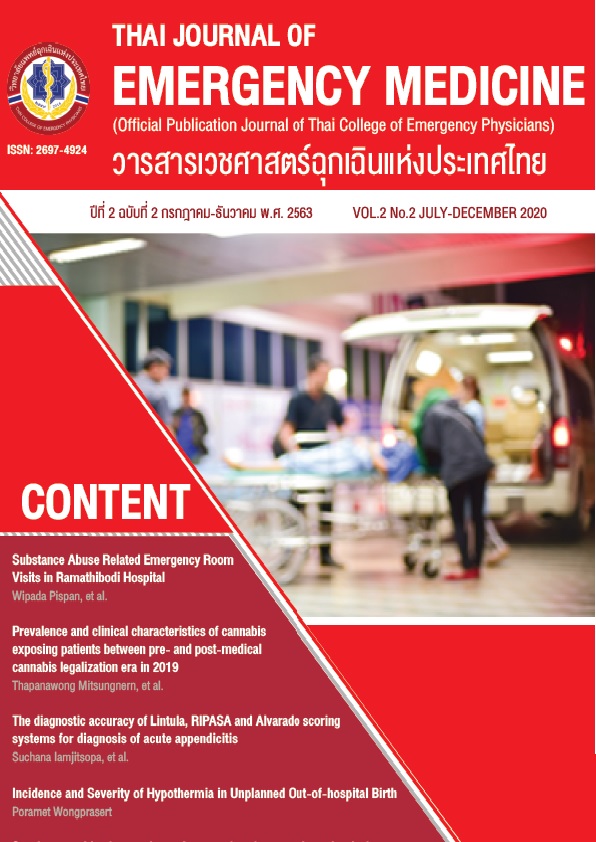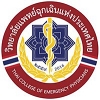Substance Abuse Related Emergency Room Visits in Ramathibodi Hospital
Keywords:
Substance abuse, amphetamines, opioids, emergency room, laboratory resultsAbstract
Introduction : Currently, substance abuse is still an important health problem in Thailand. The data of the substances and toxicology laboratory results are limited.
Objective : To describe clinical characteristics, toxicological laboratory findings, and outcomes of substance abuse patients who visited the Emergency Room (ER) in Ramathibodi Hospital, Bangkok, Thailand.
Method : We performed a retrospective study from hospital medical records of patients with history and clinical symptoms of substance abuse who visited the ER during a 9-year period(2009-2017).
Results : There were a total of 57 patients. The common groups of single substances reported were amphetamines (26.3%), opioids including tramadol (24.6%), sedatives (12.3%), and kratom (8.89). Some patients reported use of multiple substance abuse. The common presenting symptoms included confusion (33.3%), depressed level of consciousness (19.3%) and seizure (14.0%6) The common substances reported by the mass spectrometry confirmation blood or urine toxicology tests were opioids (40.5%) and amphetamines (24.3%). The medians of ER and hospital stay were 9 hours and 4 days, respectively. One patient died from an opioid overdose.
Conclusion : Amphetamines and opioids including tramadol were common substances of abuse-related ER visits. The history of substances uses together with toxidromes findings are helpful for patients' management in the ER.
References
สำนักงานคณะกรรมการป้องกันและปราบปรามยาเสพติด.แนวโน้มสถานการณ์ปัญหายาเสพติดปี 2560. แผนปฏิบัติการป้องกันและแก้ไขปัญหายาเสพติดปี 2560. 2560: 1.
สำนักงานคณะกรรมการป้องกันและปราบปรามยาเสพติด.แนวโน้มสถานการณ์ปัญหายาเสพติดปี 2562. แผนปฏิบัติการป้องกัน ปราบปราม และบําบัดรักษายาเสพติด ปี 2562
สถาบันธัญญารักษ์. จำนวนและร้อยละของผู้ป่วยยาเสพติดทั้งหมดของสถาบันธัญญารักษ์ จำแนก ตามปีงบประมาณ2557 -2561. ตุลาคม 2551. [เข้าถึงเมื่อ 2562 กุมภาพันธ์ 8]. เข้าถึงได้จาก :
http://www.pmnidat.go.th/thai/index.php?option=com_content&task=view&id=2738&Itemid=53
ภัทรมณ ยงพานิช และธนศักดิ์ เทียกทอง. อุบัติการณ์และความชุกของการใช้ยาและสารเสพติดในการประกอบอาชญา- กรรม: กรณีศึกษาโรงพยาบาลตำรวจ กรุงเทพมหานคร. วารสารวิชาการมหาวิทยาลัยอีสเทิร์นเอชีย ฉบับวิทยาศาสตร์และเทคโนโลยี 2018; 12(2): 144-52.
Substance abuse and mental health service administration. Behavioral Health Trends in the United States: Result from the 2014 National Survey on Drug Use and Health. 2015: 4-5.
Substance abuse and mental health service administration. Drug Abuse Warning Network, 2011: National Estimates of Drug-Related Emergency Department Visits. 2013: 13-34.
Wendy L. Macias Konstantopoulos, Jessica A. Dreifuss, Katherine A. McDermott, Blair Alden Parry, Melissa L. Howell, Raul N. Mandler, et al. Identifying Patients With Problematic
Drug Use in the Emergency Department: Results of Multisite Study. Annals of Emergency Medicine 2014; 64(5): 516-25
Butler K, Reeve R, Viney R, Burns L. Estimatint the prevalence of drug and alcohol
presentations to hospital emergency department in NSW, Australia: impact of hospital consultation liaison services. 2016; 26(4): e2641642
Aaron M. Orkin, Chun Zhan, Jason E. Buick, Ian R. Drennan, Michelle Klaiman, Pamela Leece, et al. Out-of-hospital cardiac arrest survival in drug-related versus cardiac cause in Ontario: A retrospective cohort study. PloS ONE 2017; 12(4): 1-14
World Health Organization. Alcohol and drug use disorders: Global Health Estimates. Available at:
Retrieved February 8, 2019.

Downloads
Published
How to Cite
License
บทความที่ได้รับตีพิมพ์ในวารสารเวชศาสตร์ฉุกเฉินแห่งประเทศไทย ถือเป็นเป็นลิขสิทธิ์ของ วิทยาลัยแพทย์เวชศาสตร์ฉุกเฉินแห่งประเทศไทย
กรณีที่บทความได้รับการตีพิมพ์ในวารสารเวชศาสตร์ฉุกเฉินแห่งประเทศไทยแล้ว จะตีพิมพ์ในรูปแบบอิเล็กทรอนิกส์ ไม่มีสำเนาการพิมพ์ภายหลังหนังสือเผยแพร่เรียบร้อยแล้ว ผู้นิพนธ์ไม่สามารถนำบทความดังกล่าวไปนำเสนอหรือตีพิมพ์ในรูปแบบใดๆ ที่อื่นได้ หากมิได้รับคำอนุญาตจากวารสารเวชศาสตร์ฉุกเฉินแห่งประเทศไทย



